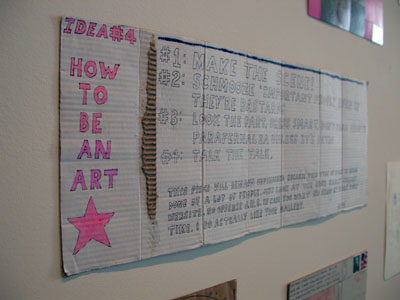
Despite its self-depricating title, Joe Macca's new body of work, Flotsam, is a successful, if sometimes uneven, venture into a more spontaneous body of work by this Portland artist known for his laboriously crafted color field paintings seen regularly at PDX. As he explains in the exhibition statement, this body of work came about during the day-to-day tedium of his studio practice, which involves many hours of waiting for thin layers of oil paint to dry. The work presented at New American Art Union is pieced together from more experimental work created during this time. These small drawings, notes, collages, video experiments and a collection of mail art all engage with, and sometimes pose a challenge to, the mechanisms of the art world.
The underlying cynicism that seems to run throughout Flotsam is somewhat mysterious, given the lack of intellectualism and the air of serenity that Macca's masterful abstractions tend to exude (I'm not the only one to have noticed a bipolarity in Macca's work). In many of the works at NAAU, it's not clear if Macca is jaded, if he still wants to believe in some sort of art utopia or if he is simply avoiding a strong point of view altogether, celebrating in the comfort of knowing that in making art after modernity, anything (and nothing) is possible. In his artist statement, Macca explains that he "invokes the participatory nature of artistic production" in this exhibition, but I can't completely buy into this overwhelming optimism given the nature of many of the works in the show.

Since this work is an outcome of experimentation in the studio, the exhibition never comes to a sharp focus, but there are plenty of rewards found in going through the show. Small, geometric collages bearing some resemblance to Constructivist works are created from clippings taken from artforum, pages containing academic critique and cultural commentary reabsorbed into purely visual, formalized abstract images. At the back of the gallery, viewers are called upon to contribute to several collaborative works. Two Collaborative Line Paintings instruct viewers to choose a colored marker and draw a line directly next to and following the same path as the previous line drawn. Although the intent is seemingly utopian in the "everyone is an artist" sense, I find the work more intriguing for the inevitable failures built into the project. The line degrades within a few iterations and some individualistic participants manage to completely disrupt the entire premises of the work. Birthday Painting attempts to follow a similar strain, but is redundant and not quite as successful as the line paintings.

Among a wall of drawings, writings, cartoonish scribbles and musings on such topics as "How to Be an Art Star" are selections from Macca's Northwest Correspondence School. Reviving modes of mail art prevalent among conceptual artists in the 1960s and 70s, Macca solicits work from friends, internationally established artists and celebrities, and I've been told the returned works are legitimate. Regardless of its authenticity, the most hilarious is a postcard to neo-geo artist Peter Halley, on which Macca writes, "Dear Mr. Halley, At your earliest convenience, please color in the drawing below." The drawing Macca refers to is an imprecise hand drawn outline of the cell with conduits Halley typically uses, colored with fluorescent marker.

A three-part video, entitled Wriggle, contains my favorite part of the exhibition, a video clip showing an idyllic scene of the artist, his dealer (Jane Beebe of PDX), a collector (Doug Pousten) and a critic (PORT's own Jeff Jahn) idyllically baking cookies together. This clip could have easily stood on its own, but Macca chose to include footage of himself executing a punishing Eckard-like performance, dragging himself by his elbows across the grass, finally raising to his feet in a classic evolutionary pose. He also includes ambient footage of a community dance in a school gym, the kind of nostalgia-soaked Americana that I've seen way too much of by now. The video provides wry commentary on the inner workings of the art world - the evolution of the artist, the symbiosis between artist/dealer/collector/critic, and the kind of clumsy social dance one must ascribe to in order to play the art game.
The cookies were really good, although Jane and I agree that Doug and Joe should not be allowed to use a kitchen unsupervised. I dont think they have taken the requisite home-ec classes and someone might get hurt...
and apparently I point a lot. damn critics!


























![[TypeKey Profile Page]](http://www.portlandart.net/nav-commenters.gif)